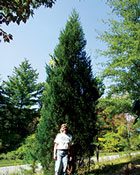 |
An eastern red cedar called my name the other day. It was hidden behind a group of other trees on a warm, dry slope at The North Carolina Arboretum. Overshadowed now by the brightly colored maples, sourwoods and dogwoods around it, this evergreen beauty will stand tall in the winter landscape.
The eastern red cedar, aka Juniperus virginiana, is actually a juniper. Its scalelike evergreen leaves, light green in summer, turn varying shades of bronze in the winter months. Typically assuming an upright, pyramidal form when young, the tree becomes more irregular with age (sound familiar?), reaching a height of 40 to 50 feet and spreading 8 to 20 feet wide.
The red cedar’s exceptionally broad range — the largest of any North American conifer — extends from Nova Scotia to northern Florida and west to the Dakotas and Texas. This tree is tough; it will grow in soils of any pH level, from the driest and rockiest of sites to moist, loamy soil (as long as it’s well-drained).
Eastern red cedar does best in full sun; it’s most often found in abandoned fields or recently cleared land. Anyone traveling east on Interstate 40 in the Piedmont can attest to the plant’s prevalence, especially along fence lines and in hedgerows. If you ever run across one in the forest, it’s probably a remnant of an abandoned field.
The fruit — a bright, waxy, blue berry — is an important food for almost a dozen species of birds, from cedar waxwing to wild turkey. That’s why we see this pioneer species growing up around fences, where birds like to roost. Joan Maloof’s book, Teaching the Trees: Lessons From the Forest (University of Georgia Press, 2005), includes a delightful chapter on the eastern red cedar. The author recounts how a scientist studied the perching and pooping of birds and the subsequent growth of trees in open fields. Trees tended to grow near posts measuring 12 feet or more, but not in open fields or near shorter posts.
Maloof concludes that if you want to convert your open yard to woods, you can speed up the process by installing posts — and then doing nothing. The birds will come and drop the seeds for you, and trees will grow. Be careful, though: Around here, you’re more likely to end up with bittersweet and multiflora rose than with eastern red cedar and persimmon.
The eastern red cedar also provides other resources. The dense foliage offers important protective shelter for nesting birds. Humans have long used the leaves’ aromatic oils for teas and tonics. And the fine-grained, very fragrant and durable wood turns up in such diverse products as pencils, furniture, paneling and fence posts.
Considering the red cedar’s ability to grow in the harshest conditions, why don’t we see it more often? Although there are more than 30 cultivars, you rarely run across them locally. I asked several nursery men about this and was told that they’re hard to propagate by rooted cuttings and, if they do root, it takes a few years to develop a strong root system. One nursery man confessed that he doesn’t get many requests for them. I suspect the average homeowner either isn’t familiar with the tree or regards this native juniper as a weed. A plant with no reputation — or, worse, a bad rep — simply doesn’t sell.
That’s unfortunate, given the tree’s obvious contributions both to the natural world and to the landscape. Used as a specimen, screen, hedge or windbreak, this plant diversifies a garden while increasing its functionality. It also conveys a sense of regional identity. For this reason alone, it should not be discounted!
But there’s yet another reason that some gardeners — especially apple growers — have rejected the eastern red cedar: a fungal disease called cedar apple rust. To complete its life cycle, the fungus must infect apple or crab-apple trees and an alternate host. And in this case, that alternate host is the eastern red cedar. It doesn’t bother the tree when dull, brown galls formed the previous season come alive, sprouting bright-orange, gelatinous horns in the spring. But the wind disperses the developing spores, which infect the leaves of apple and crab-apple trees.
At first, the fruit isn’t seriously damaged. But over time, severe defoliation can reduce fruit size and weaken the tree, requiring intensive management to ensure the orchard’s long-term health. So if you live near an orchard, do the neighborly thing and avoid bringing eastern red cedar into your garden. The same holds true if you grow apples, crab apples or hawthorns yourself (there’s also a cedar hawthorn rust).
Still, it seems a shame to let a few flaws prevent us from seeing a tree’s true beauty and purpose. So the next time you’re driving down the road and notice this quiet native standing sentinel in a field, nod your head in recognition and know that it has its place in the world — just like you.
[Alison Arnold is director of horticulture at The North Carolina Arboretum. She can be reached at 665-2492.]


Before you comment
The comments section is here to provide a platform for civil dialogue on the issues we face together as a local community. Xpress is committed to offering this platform for all voices, but when the tone of the discussion gets nasty or strays off topic, we believe many people choose not to participate. Xpress editors are determined to moderate comments to ensure a constructive interchange is maintained. All comments judged not to be in keeping with the spirit of civil discourse will be removed and repeat violators will be banned. See here for our terms of service. Thank you for being part of this effort to promote respectful discussion.